We all love online shopping 🛒👜! Browsing products online, adding them to carts, and purchasing them gives so much satisfaction. One of the greatest places to explore products is Google Shopping!
But, today’s blog is not about purchasing on Google Shopping. Today’s blog is about promoting products on Google Shopping Feed🛍️💳
If you’re not promoting your products on Google Shopping, you’re losing a valuable opportunity.
We created this guide to direct you on how to create Google Shopping Feed and give you a better idea about this platform.
What is Google Shopping Feed?
When you search for a product on Google, one of the first things you’ll see on the search page is the Shopping feed. For example, when I searched for home workout equipment on Google, the first thing I got was the shopping feed. Refer to the below image.
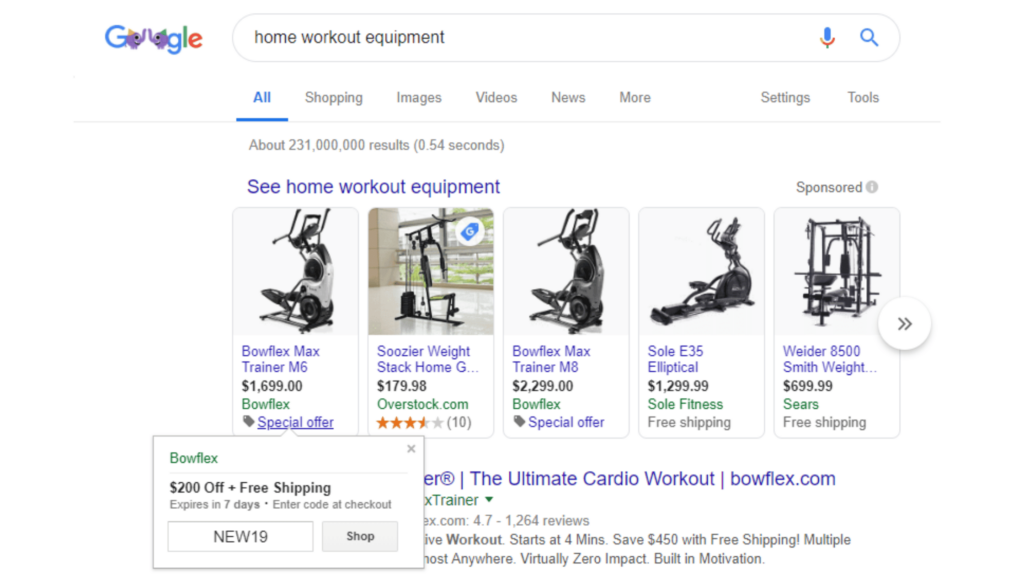
Google Shopping is a service provided by Google, that helps people to search, compare, and buy physical products from various retailers who have paid to advertise their products. Results on Google Shopping appear as thumbnail images, showing the product along with product information like, retailer and price information.
History of Google Shopping:

When it launched in 2002, Google Shopping was known as Froogle. Initially, the service indexed product data according to specific search terms.
However, in 2012, it transitioned to a paid advertising model where retailers had to pay to have their products featured in Google Shopping search results.
Since then, Google Shopping has become a part of Google AdWords, offering retailers and e-commerce businesses another avenue to advertise their physical products. Unlike text-based Google ads that appear based on keywords, Google Shopping ads are displayed using product data uploaded by merchants.
How to Create Google Shopping Feed?
Let’s discuss how to set up Google Shopping Feed. We will walk you through the steps on how to add your products to Google Shopping.
1.Set up a Google Merchant Center
If you want to feature your products on Google Shopping Results, you need to sign up for a Google Merchant Center account.
You need a Google Account to sign up for a Google Merchant Center account. You can refer below tutorial on how to create a Google account for your business,
Now, click this link to create your Google Merchant Center account for free.
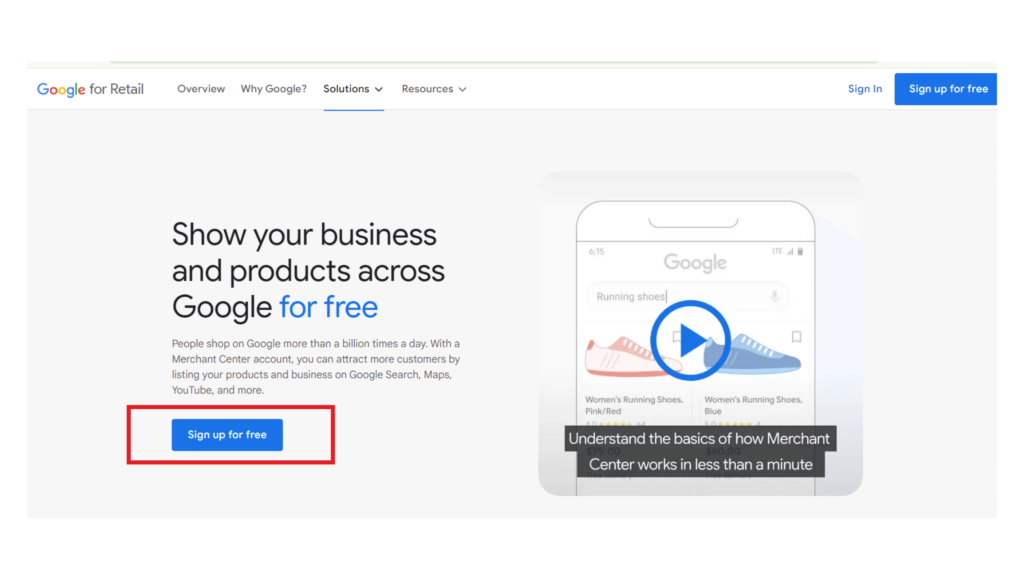
Then Google asks some questions about your business. It will ask if your business is online or sells products physically.
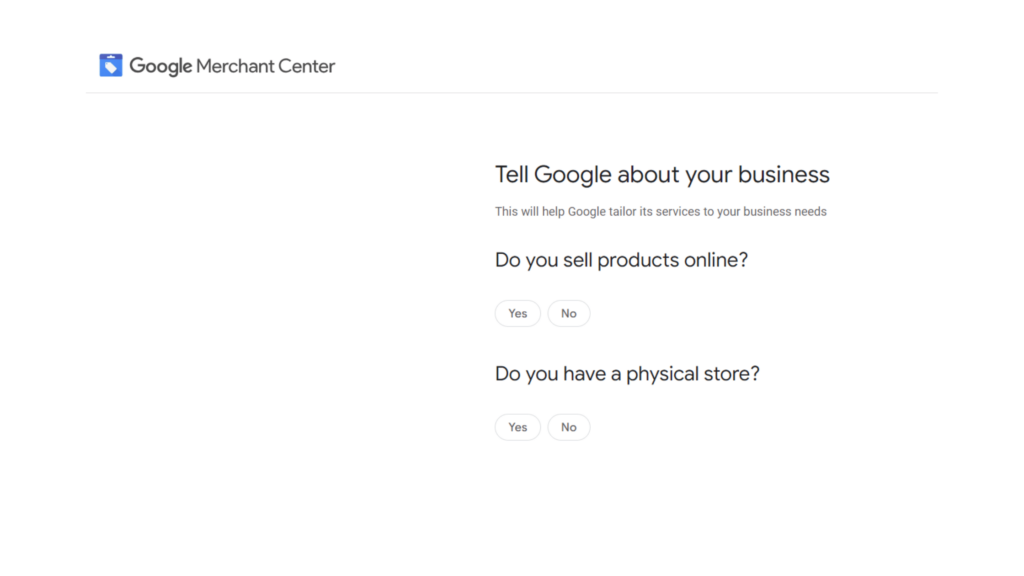
Then you will need to add the basic business information. Follow Google’s instructions to ensure you add all necessary information, which typically includes the business name, address, website URL, and contact details. Additionally, you need to provide a phone number for verification purposes.
To link your website to the merchant account, Google will guide you through the process of verifying ownership and claiming your website URL. This can be done by adding an HTML tag or uploading an HTML file to your site. Alternatively, if you’re already using Google Analytics on your site, you may opt to verify through that platform.
During setup, you’ll have the opportunity to select the countries you deliver to, select a currency, and select delivery locations.
Google will offer suggestions for setting up taxes based on your business’s location. You can choose to allow Google to determine the appropriate amount of sales tax to collect automatically or opt to configure this manually. Additionally, you can specify whether shipping and handling charges should be subject to taxation.
2. Optimize product images.

Google Shopping relies on uploaded product feeds to index search results, but it retrieves the featured images directly from the corresponding retail websites. Therefore, it’s crucial to optimize your product imagery and listings on your website before promoting them on Google Shopping.
In Google Shopping, product visuals play a powerful role. Your product photos are the most essential aspect of your listing. That is because they decide which product shoppers choose to purchase.
Google Shopping is a highly visual experience. Your product photos are arguably the most important part of your listing, and they may be how shoppers choose which product to click and buy.
If you want to get your products featured on Google Shopping, you need to follow Google’s image guidelines.
Google provides several guidelines for product images in the Google Shopping feed:
(a).Ensure your image meets these size requirements.
- For non-apparel images: minimum 100 x 100 pixels
- For apparel images: minimum 250 x 250 pixels
- Maximum image size: 64 megapixels
- Maximum file size: 16MB
Following these guidelines will result in a high-quality image showcasing your product at its best.
(b).Avoid using generic images.
Avoid using generic images, graphics, or illustrations that do not accurately represent the actual product. However, a generic image, graphic, or illustration is permitted for products in the following categories:
- Hardware
- Vehicles & Parts
- Computer Software
(c ).Do not use logos or icons.
Do not use a logo or icon in place of an actual product image, unless you are representing a software product. In this case, software logos or icons can be used to represent your software product in the specified Google product category.
(d).Do not use single-color images.
Avoid using a single-color image that is merely a square of color unless your product falls into one of the following Google product categories:
- Vehicle Paint
- Craft Paint, Ink & Glaze
- Painting Consumables
(e). Avoid promotional content on the images.
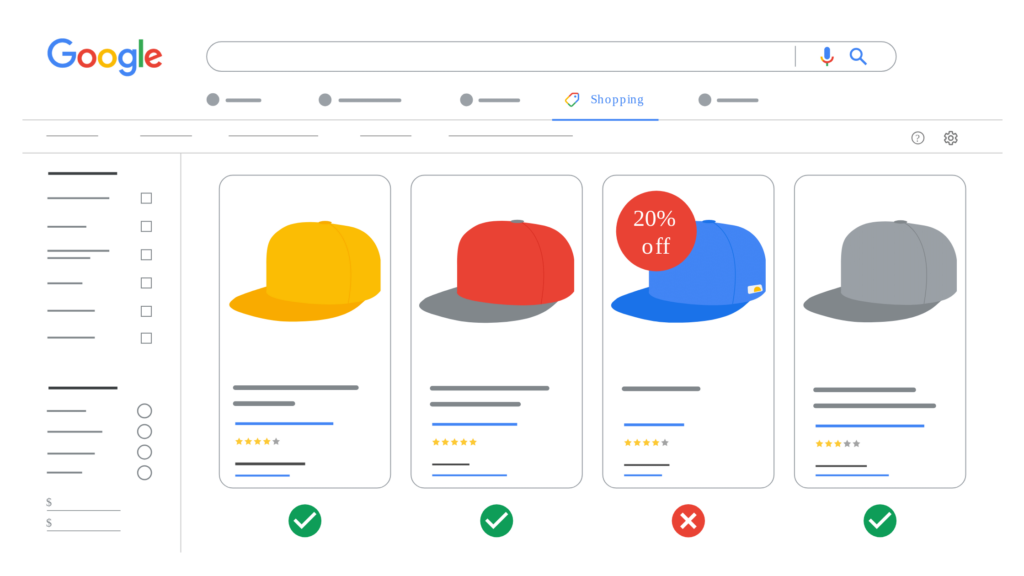
Do not use an image that contains promotional elements or content covering the product.
Examples of promotional elements include:
🖼️Calls to action (e.g., “buy”)
🖼️Service-related information like extended warranty
🖼️Free shipping details
🖼️Price information
🖼️Promotional adjectives (e.g., “best,” “cheap”)
🖼️Product condition or compatibility (e.g., “new,” “2-piece,” “adaptable”)
🖼️Overlays such as watermarks, brand names, or logos
Barcodes
🖼️Brand, manufacturer, or retailer name
🖼️Brand, manufacturer, or retailer logo
3.Collect and input product data feed.
Now that you optimized your images, it’s time to create your product data feed. This feed provides Google with comprehensive information about your products, helping it to find and show them effectively when users search for specific product terms or attributes.
To set up your product feed, go to your Google Merchant Center account, click on “Products” > “Feeds,” and then select the blue “+” icon.

Then follow these steps:
- First, enter your country and language. This information determines the demographic(s) that will see your products, making it crucial.
- Next, name your product feed and select how you’ll input your product information.
- If you select the Google Sheets option, you can either upload your own spreadsheet or use a template provided by Google Merchant Center. This step also helps you to establish an upload schedule based on your inventory update frequency.
- The spreadsheet is used to collect the product attributes that Google uses to index and display your products. Here’s a list of some required product attributes that Google uses to create your Google Shopping ads
Attribute | Description | Example |
ID | Your product’s unique identifier, such as the SKU | P123 |
Product Title | Your product’s title. It should match the product landing page and specific details like size, color, or style | Premium Stainless Steel Kitchen Knife Set, 8 Pieces |
Product description | An accurate description of your product, matching the product landing page and providing relevant information | This premium kitchen knife set includes 8 high-quality stainless steel knives, perfect for all your cooking needs. |
Link | The URL of your product’s landing page, beginning with http or https. | https://www.example.com/knife-set |
Image link | The URL of your product’s main image, beginning with http or https. | https://www.example.com/knife-set/image1.jpg |
Availability | Your product’s availability aligns with the information on the product landing page. | In stock |
Product price | Your product’s price. It should match the information on the product landing page and the currency of the primary selling country. | $79.99 |
Google Product Category | The Google-defined product category for your product, selecting the most relevant category | Kitchen & Dining |
Brand name | Your product’s brand name, recognized by customers | Sharp Knives |
If you decide to create your own spreadsheet, use your selected product attributes as the column headers. Then, fill in the data for each product in its own row. If a particular attribute doesn’t apply to a product, leave that cell empty. Once you’ve finished, upload the document to Google Merchant Center.
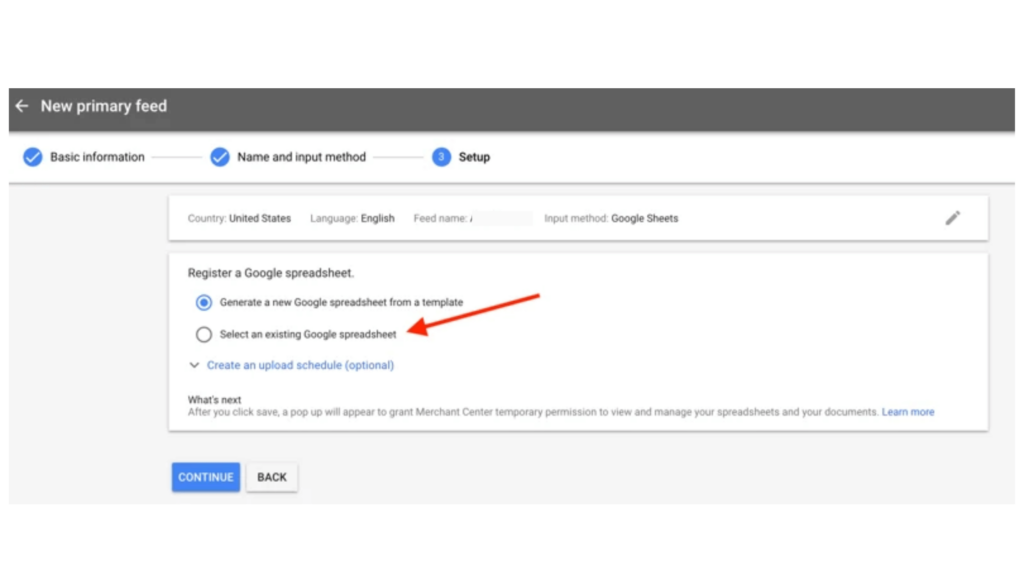
Great! Now, you can access your product feed on the Google Merchant Center by using this path: Products > Feeds > Primary feeds
4.Link your Google AdWords account to the Google Merchant Center
When you search for a product on Google, the Google Shopping results displayed are essentially advertisements. To have your products featured on Google Shopping, you need to invest in advertising.
To ensure your products are visible to shoppers on Google Shopping, you must link your Google AdWords account. Here’s how:
Log into your Google Merchant Center account.
Locate the three vertical dots in the top right-hand corner and click on them to expand the menu.
Then, select “Account linking.”
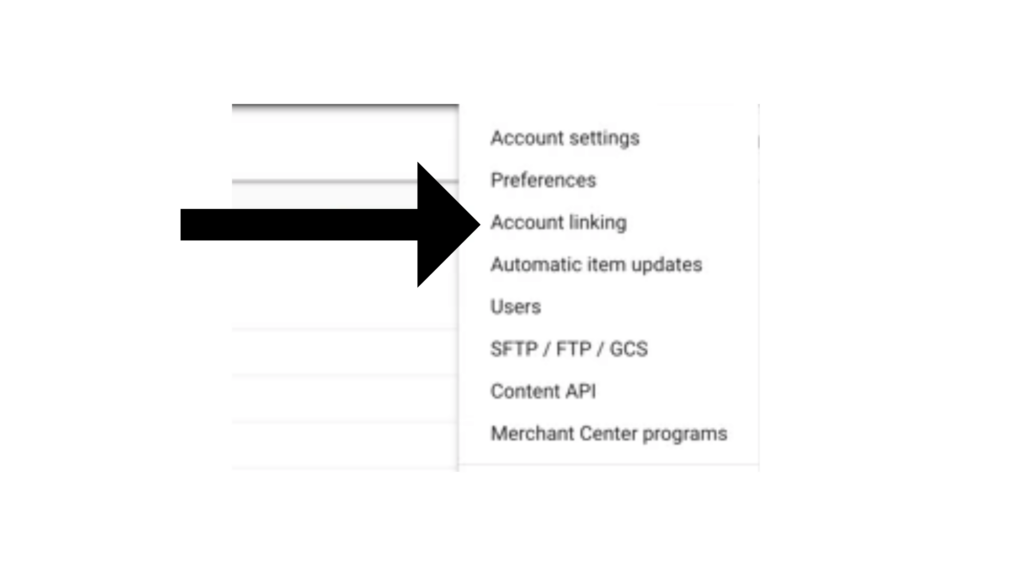
Then click “Link account” to enter your Google AdWords customer ID. After completing this step, your AdWords account will be successfully linked.
5.Create a Google Shopping campaign.
Once your Google AdWords account is linked, you’ll have the opportunity to set up a Google Shopping campaign and promote your products. There are several methods to initiate this process.
1st method:
- One method is to create a Google Shopping campaign directly within your Google Merchant Center account. After linking your Google AdWords account via the Account linking page, you should be able to access it from the same location. Then, simply click on “Create Shopping Campaign.”
- Next, enter the campaign name, select the country of sale, and set your daily budget. After clicking “Create,” you’ll be guided to manage your campaign further through Google AdWords.
2nd method:
Another method to create a Google Shopping campaign is through Google AdWords. Here’s how:
- Log into your Google AdWords account.
- Navigate to the Campaigns tab on the left-hand side menu.
- Click the blue “+” icon, and select “New campaign.”
- Select a campaign goal. A Shopping campaign can aim for Sales, Leads, or Website traffic. You can identify the Shopping designation by hovering over the goal option.
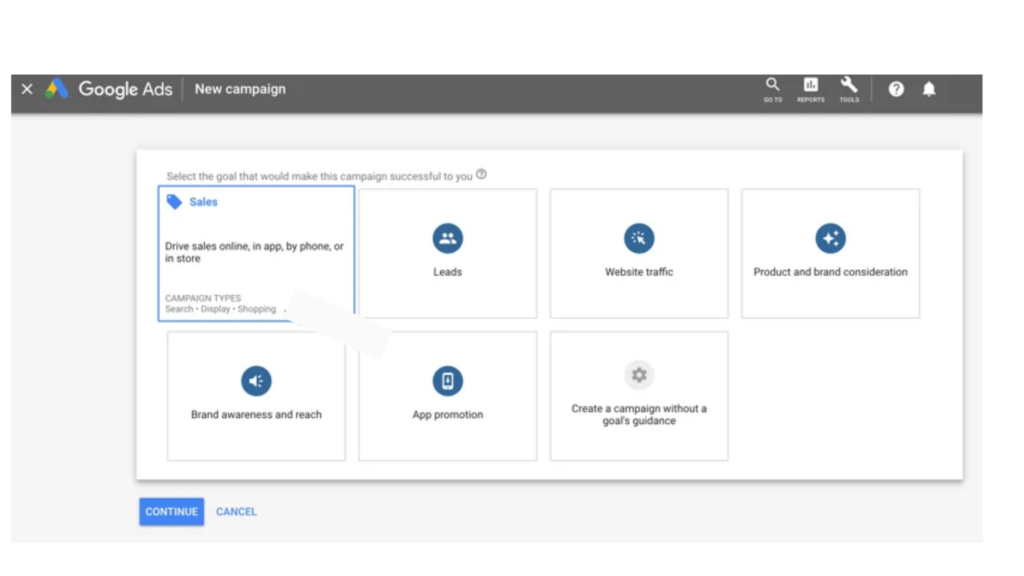
Choose a campaign goal that aligns with your business objectives. Sales campaigns drive online or in-person sales, Leads campaigns gather leads and other conversions by prompting shoppers to take action, and Website traffic campaigns attract relevant visitors to your website.
Google tailors each campaign to suit your goal, so select the one that best fits your business needs.
- After selecting a campaign goal, specify the campaign type as Shopping. Ensure that your Google Merchant Center account is displayed so that Google AdWords can access your product data. Also, indicate the country where your products are being sold.
- Lastly, select a campaign subtype. Note that Smart Shopping campaigns require conversion tracking, enabling AdWords to monitor when your ads result in sales on your website.
6.Select a Bidding strategy for your campaign.
Now, in your Google Shopping settings, proceed to select your bidding strategy and establish your campaign budget.
Bidding is the process by which you pay for viewers to see, click on, and engage with your ads. According to Google, “a sufficient bid and high-quality product data will earn your ad a higher rank.”
Firstly, choose your bid strategy. With Manual CPC (cost-per-click), you determine your own maximum CPC (cost-per-click) for your ads. Alternatively, you can opt for an automated bid strategy. Both Target ROAS (return on ad spend) and Enhanced CPC require conversion tracking, as Google utilizes your ad’s conversion rates to set the most effective bid for your products.
Selecting “Maximize clicks” means that Google Ads automatically adjusts your bids to maximize the number of clicks within your budget. You can also set a Maximum CPC bid limit to control your spending on each ad.
Next, specify your campaign budget. This represents the average amount you wish to spend per day. However, this amount isn’t strictly capped on a daily basis. Instead, Google manages your budget monthly, ensuring that you don’t exceed your total budget for the month.
As an example, suppose I set my campaign budget to $100 for February. Google recognizes that I’m willing to spend $100 x 28 days = $2,800 for February. While placing bids on my ads, Google might exceed $100 in a single day, but it will always ensure that the total expenditure stays within the $2,800 monthly limit.
7.Target and schedule your shopping campaign
This last step involves targeting and scheduling your campaign. This part is crucial as it determines who will see your product ads and when.
The first two settings, Networks and Devices, remain unchanged. They simply show where your product ads will appear.
Next, choose the locations that your ad will target. Ensure you select only locations where you operate or can ship to. Under Location options, you can adjust the Target and Exclude settings, although Google’s default choices are recommended. These options ensure you’re marketing to the most relevant audience: those in your target location and those interested in those locations.
Finally, specify the start and end dates of your Shopping campaign. Unless you set an end date, your ad will continue to run indefinitely, so remember to include this information.
Google Shopping feed types
Now you are well aware of how to create Google Shopping feed for your business. But, did you know that there are six types of Google shopping feeds?
Let’s explore these feeds.
1.Google Merchant Center feed
The main feed in Google Merchant Center is the primary display platform for your products on the search results page.
It serves as a central showcase where potential customers can view images of your products, their prices, your brand name, and even star ratings if reviews are available.
This feed acts as the main presentation of your products to users who are searching for related items, allowing them to quickly assess and compare products before making a purchasing decision.
2. Product inventory update feed
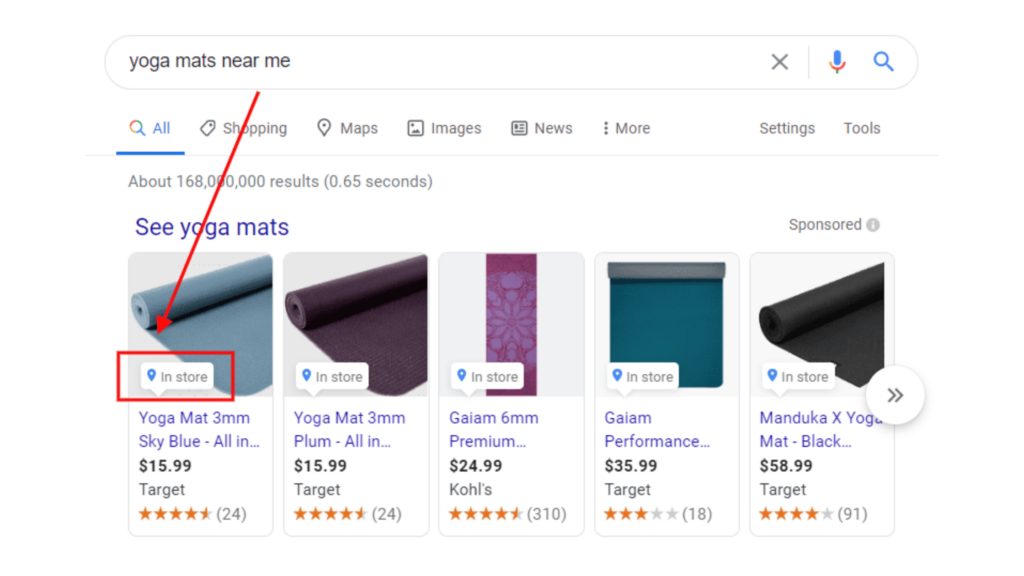
Another significant type of Shopping feed is the “product inventory update” feed. Unlike the main feed, this one is dedicated to showcasing the availability and pricing of products. Its primary purpose is to provide information about product stock levels.
In the Shopping feed, you may come across labels such as “In store” or “In stock”. Clicking on an item might reveal its current availability. At times, Google may directly show “In stock” in the feed without requiring additional clicks. It’s essential to regularly update your inventory feeds to ensure that the information remains accurate and up-to-date.
3. Promotions feed
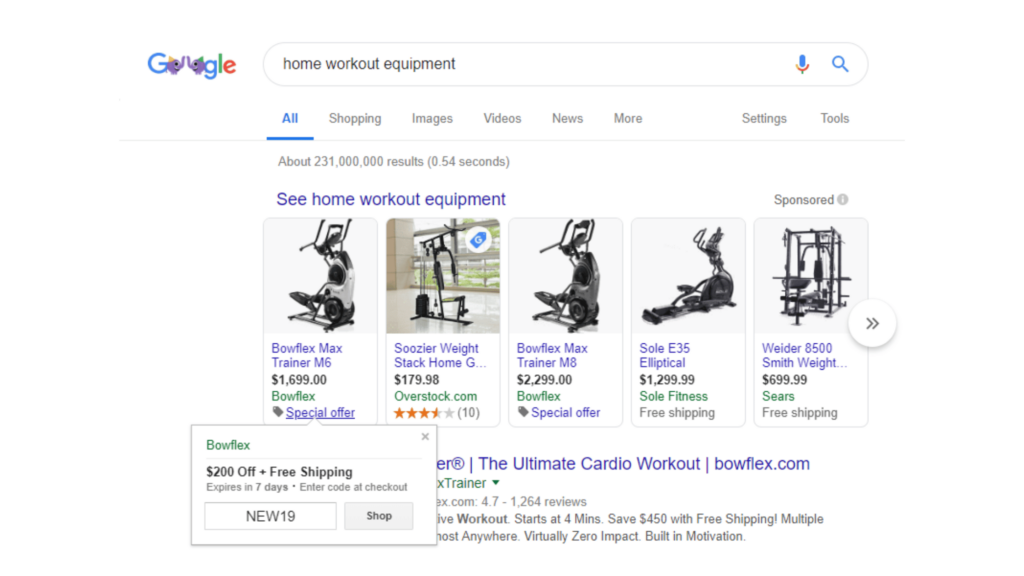
A promotions feed closely resembles the standard Shopping feed, with only minor differences. It includes information about ongoing product promotions or shopping ad campaigns. For example, it may highlight if a product is part of a sale or if there’s a discounted price available for a particular item.
The promotions feed must contain six essential pieces of information: promotion ID, product applicability, offer type, long title, promotion effective dates, and redemption channel. These details ensure that promotions are accurately conveyed to potential customers and properly integrated into advertising campaigns.
4.Local inventory ads feed
The local inventory ads feed resembles the product inventory update feed, focusing on stock details and catering particularly well to physical stores.
However, what sets this feed apart is its capability to offer local pickup as an option.
To set up this product data feed, you’ll need your store code, current product details, item identifier, quantity, and at least the price. Regular updates for these data feeds are essential to ensure the accuracy of the information provided.
5.Product ratings feed
The product ratings feed plays a critical role in the Google Shopping sales channel. It often accompanies the regular Shopping feed products and consists of listings that showcase review ratings.
Stores have two methods to convert regular feed items into rating feeds:
Submit feeds to Merchant Center: This involves sending feeds directly to your merchant center account.
Use a third-party review service: Alternatively, you can use an external review aggregation service. In this scenario, Google retrieves data directly from the aggregator. No additional feed submissions are required. However, if you collect reviews on your store, you must opt for the first option and ensure consistent updates to the feed.
6.Dynamic remarketing feed
The final type of Google Shopping feed is dynamic remarketing. These ads are aimed at individuals who have previously visited your site or abandoned items in their cart. They appear as standard Shopping feed items, positioned closer to the beginning of the feed.
However, due to Google’s gradual phase-out of third-party cookies, which are essential for tracking user web activity and a key component of retargeting, this feed type may be discontinued within the next few years.
For manual feed management, you’ll need XML or TXT files containing the required fields: id, title, description, link, image_link, price, condition, availability, brand, and gain. You can create these files using Google Sheets or Excel and then export them to the specified formats.
Elevate Your Google Shopping Feed
Discover how Digifix can elevate your online presence with our expert Google Merchant Center services. Let us optimize your product listings, enhance your visibility on Google Shopping, and drive more sales for your business
Do you want more traffic?
—————
Hi, we are an Australian digital agency doing groundbreaking work to help a business like yours reach its full potential. My only question is will you qualify for our services?
Do you want more traffic?
—————
Hi, we are an Australian digital agency doing groundbreaking work to help a business like yours reach its full potential. My only question is will you qualify for our services?


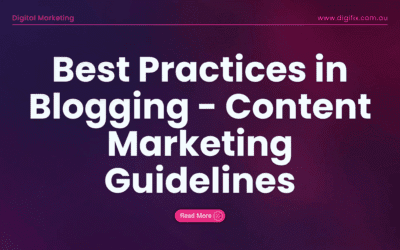


0 Comments